英语六年级上册第一单元
人教版六年级上册英语第一单元知识点
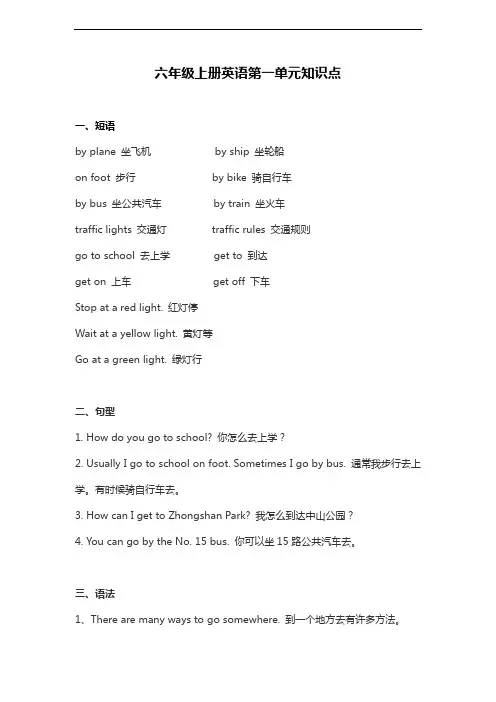
六年级上册英语第一单元知识点一、短语by plane 坐飞机by ship 坐轮船on foot 步行by bike 骑自行车by bus 坐公共汽车by train 坐火车traffic lights 交通灯traffic rules 交通规则go to school 去上学 get to 到达get on 上车get off 下车Stop at a red light. 红灯停Wait at a yellow light. 黄灯等Go at a green light. 绿灯行二、句型1. How do you go to school? 你怎么去上学?2. Usually I go to school on foot. Sometimes I go by bus. 通常我步行去上学。
有时候骑自行车去。
3. How can I get to Zhongshan Park? 我怎么到达中山公园?4. You can go by the No. 15 bus. 你可以坐15路公共汽车去。
三、语法1、There are many ways to go somewhere. 到一个地方去有许多方法。
这里的ways一定要用复数。
因为there are是There be句型的复数形式。
2、on foot 步行乘坐其他交通工具大都可以用介词by…,但是步行只能用介词on。
3、go to school的前面绝对不能加the,这里是固定搭配。
4.、USA 和US 都是美国的意思。
另外America也是美国的意思。
【本文部分素材和图片来源于网络,侵删】。
六年级英语上册第一单元教案
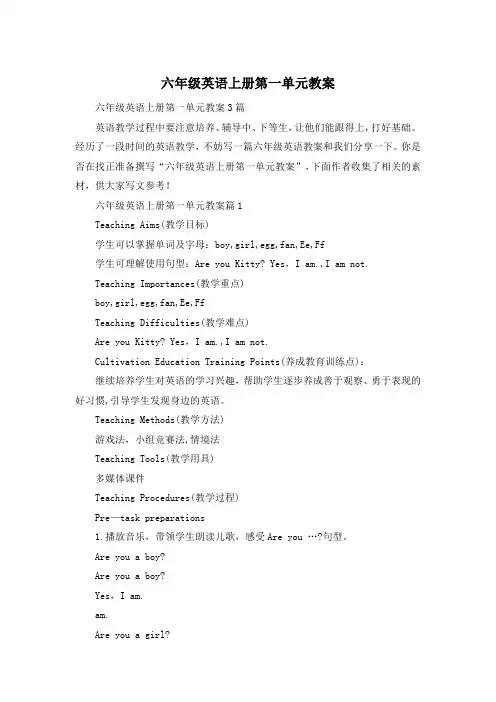
六年级英语上册第一单元教案六年级英语上册第一单元教案3篇英语教学过程中要注意培养、辅导中、下等生,让他们能跟得上,打好基础。
经历了一段时间的英语教学,不妨写一篇六年级英语教案和我们分享一下。
你是否在找正准备撰写“六年级英语上册第一单元教案”,下面作者收集了相关的素材,供大家写文参考!六年级英语上册第一单元教案篇1Teaching Aims(教学目标)学生可以掌握单词及字母:boy,girl,egg,fan,Ee,Ff学生可理解使用句型:Are you Kitty? Yes,I am.,I am not.Teaching Importances(教学重点)boy,girl,egg,fan,Ee,FfTeaching Difficulties(教学难点)Are you Kitty? Yes,I am.,I am not.Cultivation Education Training Points(养成教育训练点):继续培养学生对英语的学习兴趣,帮助学生逐步养成善于观察、勇于表现的好习惯,引导学生发现身边的英语。
Teaching Methods(教学方法)游戏法,小组竞赛法,情境法Teaching Tools(教学用具)多媒体课件Teaching Procedures(教学过程)Pre—task preparations1.播放音乐,带领学生朗读儿歌,感受Are you …?句型。
Are you a boy?Are you a boy?Yes,I am.am.Are you a girl?Are you a girl?No,I'm not.No,I'm not.2.请个别学生用课时一学过的句子介绍自己。
S1:Hi,I'm…(name)'m a… (boy).While-task procedures1.出示Listen and say的图片,播放录音或多媒体动画,让学生跟读对话。
(六年级)六年级上册英语第一单元知识点
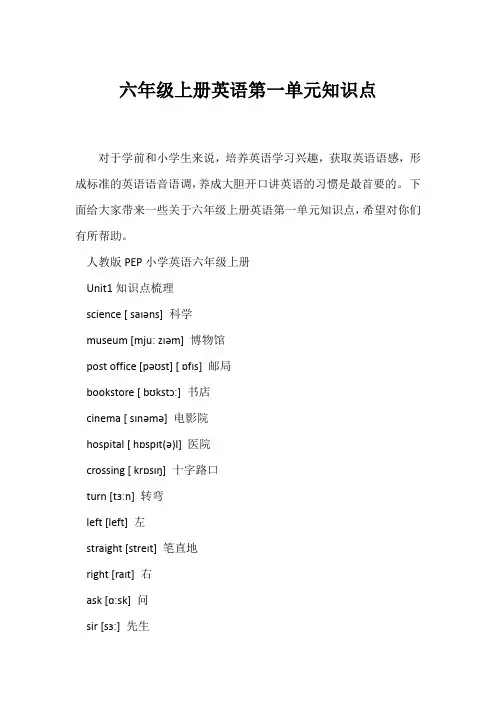
六年级上册英语第一单元知识点对于学前和小学生来说,培养英语学习兴趣,获取英语语感,形成标准的英语语音语调,养成大胆开口讲英语的习惯是最首要的。
下面给大家带来一些关于六年级上册英语第一单元知识点,希望对你们有所帮助。
人教版PEP小学英语六年级上册Unit1知识点梳理science [ saɪəns] 科学museum [mjuː zɪəm] 博物馆post office [pəʊst] [ ɒfɪs] 邮局bookstore [ bʊkstɔː] 书店cinema [ sɪnəmə] 电影院hospital [ hɒspɪt(ə)l] 医院crossing [ krɒsɪŋ] 十字路口turn [tɜːn] 转弯left [left] 左straight [streɪt] 笔直地right [raɪt] 右ask [ɑːsk] 问sir [sɜː] 先生interesting [ ɪntrəstɪŋ] 有趣的Italian [ɪˈtæljən] 意大利的restaurant [ˈrestərɒnt] 餐馆pizza [ piːtsə] 披萨饼street [striːt] 大街;街道get [get] 到达GPS 定位系统gave [ɡeɪv] (give的过去式) feature [ fiːtʃə] 特点follow [ fɒləʊ] 跟着far [fɑː] 较远的tell [tel] 告诉Unit 1 How can I get there重点:询问某地在哪里的问句及其答语询问怎样到某地的句型动词want的用法难点:能够问路并描述路线Wha引导的感慨句四会单词短语science科学museum博物馆bookstore书店cinema电影院hospital医院crossing十字路口tumn转弯left左straight笔直地right右post office邮局三会单词短语ask问sir(对男子的礼貌称呼)先生interesting有趣的Italian意大利的restaurant餐馆pizza比萨饼street大街;街道get到达GPS全球(卫星)定位系统gave(give的过去式)提供;交给feature特点follow跟着far较远的tell告诉get to到达in front of…在……前面惯用表达式1.Excuse me.打搅了。
六年级上册英语第一单元单词
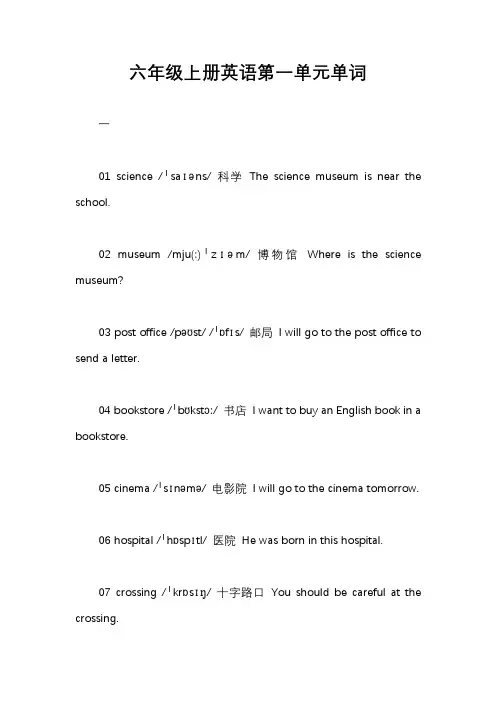
六年级上册英语第一单元单词一01 science /ˈsaɪəns/ 科学The science museum is near the school.02 museum /mju(ː)ˈzɪəm/ 博物馆Where is the science museum?03 post office /pəʊst/ /ˈɒfɪs/ 邮局I will go to the post office to send a letter.04 bookstore /ˈbʊkstɔː/ 书店I want to buy an English book in a bookstore.05 cinema /ˈsɪnəmə/ 电影院I will go to the cinema tomorrow.06 hospital /ˈhɒspɪtl/ 医院He was born in this hospital.07 crossing /ˈkrɒsɪŋ/ 十字路口You should be careful at the crossing.08 turn /tɜːn/ 转弯You should turn right at the park.09 left /left/ 左;左边You should turn left at the crossing.10 straight /streɪt/ 笔直地Turn right. Then go straight.11 right /raɪt/ 右;右边Turn right here.12 ask /ɑːsk/ 问Can I ask you some questions?13 sir /sɜː/ 先生Can I help you, sir?14 interesting /ˈɪntrɪstɪŋ/ 有趣的This book is very interesting.15 Italian /ɪˈtæliən/ 意大利的My cousin is an Italian girl.16 restaurant /ˈrestrɒnt/ 餐馆This is a new restaurant.17 pizza /ˈpiːtsə/ 比萨饼I like pizza.18 street /striːt/ 大街;街道The cinema is on Dongfang Street.19 get /get/ 到达How can I get there?20 GPS /ʤiː-piː-es/ 全球(卫星)定位系统The GPS is new.21 gave /geɪv/ 提供;交给I gave my sister a pen this morning.22 feature /ˈfiːʧə/ 特点The dog has a new feature.23 follow /ˈfɒləʊ/ 跟着Follow your mother, please.24 far /fɑː/ 远的,遥远的My home is far from the zoo.25 tell /tel/ 告诉,讲述Let me tell you my name.二六上Unit1home 家time 时间clock 钟表house 房屋;房子study 书房;学习Kitchen 厨房toilet 坐便器;卫生间floor 地板;楼层there 在那里(表示存在或发生)breakfast 早餐table 桌子put 放;安置half 一半;半数dinner 晚餐dirty 脏的lunch 午餐me 我(I的宾格形式)him 他(he的宾格形式)card 纸牌;卡片them 他(她、它)们(they的宾格) Mr. 先生Mrs. 夫人、太太。
英语六年级上册第一单元知识
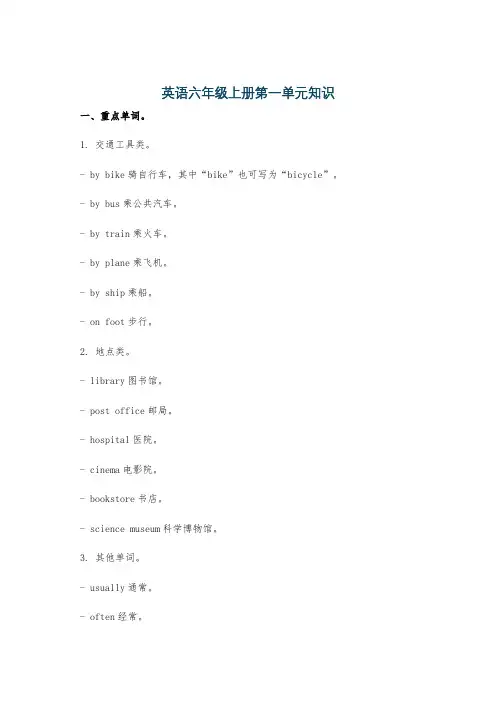
英语六年级上册第一单元知识一、重点单词。
1. 交通工具类。
- by bike骑自行车,其中“bike”也可写为“bicycle”。
- by bus乘公共汽车。
- by train乘火车。
- by plane乘飞机。
- by ship乘船。
- on foot步行。
2. 地点类。
- library图书馆。
- post office邮局。
- hospital医院。
- cinema电影院。
- bookstore书店。
- science museum科学博物馆。
3. 其他单词。
- usually通常。
- often经常。
- sometimes有时。
- near在……附近。
- next to紧邻;在……旁边。
- far from离……远。
二、重点句型。
1. 询问交通方式。
- How do you come to school? 你怎么来上学的?- 回答:I come to school on foot/by bike/by bus…我步行/骑自行车/乘公共汽车来上学……2. 询问地点位置。
- Where is the post office? 邮局在哪里?- 回答:It's near/next to/far from…它在……附近/紧邻……/离……远。
例如:It's next to the library.它在图书馆旁边。
3. 描述出行习惯。
- I usually/often/sometimes go to the bookstore by bike.我通常/经常/有时骑自行车去书店。
三、语法知识。
1. 一般现在时。
- 在描述经常发生的动作或存在的状态时,使用一般现在时。
在一般现在时中,当主语是第三人称单数(he/she/it等)时,动词要使用第三人称单数形式(动词+s 或es等)。
例如:He often goes to school by bus.(go变为goes)- 当主语不是第三人称单数时,动词用原形。
六年级上册英语第一单元
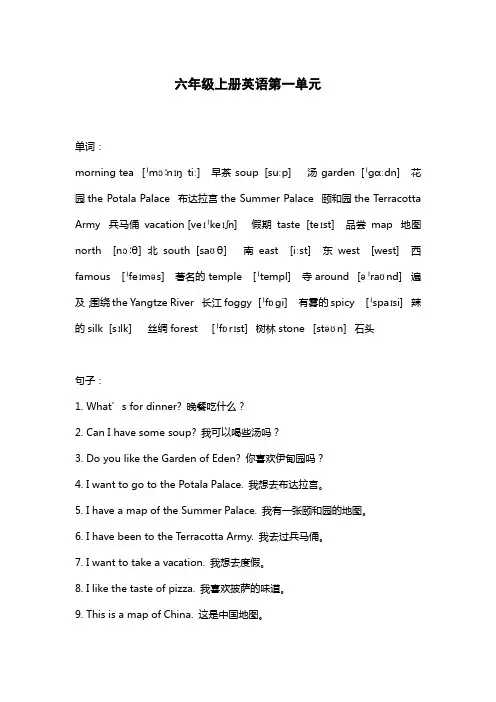
六年级上册英语第一单元单词:morning tea [ˈmɔːnɪŋtiː] 早茶soup [suːp] 汤garden [ˈɡɑːdn] 花园the Potala Palace 布达拉宫the Summer Palace 颐和园the Terracotta Army 兵马俑vacation [veɪˈkeɪʃn] 假期taste [teɪst] 品尝map 地图north [nɔːθ] 北south [saʊθ] 南east [iːst] 东west [west] 西famous [ˈfeɪməs] 著名的temple [ˈtempl] 寺around [əˈraʊnd] 遍及;围绕the Yangtze River 长江foggy [ˈfɒɡi] 有雾的spicy [ˈspaɪsi] 辣的silk [sɪlk] 丝绸forest [ˈfɒrɪst] 树林stone [stəʊn] 石头句子:1. What’s for dinner? 晚餐吃什么?2. Can I have some soup? 我可以喝些汤吗?3. Do you like the Garden of Eden? 你喜欢伊甸园吗?4. I want to go to the Potala Palace. 我想去布达拉宫。
5. I have a map of the Summer Palace. 我有一张颐和园的地图。
6. I have been to the Terracotta Army. 我去过兵马俑。
7. I want to take a vacation. 我想去度假。
8. I like the taste of pizza. 我喜欢披萨的味道。
9. This is a map of China. 这是中国地图。
10. The north is cold in winter. 北方冬天很冷。
对话:1. Excuse me, where is the nearest restaurant? 打扰一下,最近的餐厅在哪里?2. Can you tell me how to get to the Potala Palace? 你能告诉我怎么去布达拉宫吗?3. I'm looking for the Summer Palace. 我正在找颐和园。
PEP六年级上册英语第一单元知识点
PEP六年级上册英语第一单元知识点六年级上册英语知识点归纳Unit 1: How can I get there?一、重点词汇:(一)、四会词汇:(要求听说读写)1.公共场所:XXX)postoffice(邮局)bookstore(书店)cinema(电影院)hospital(医院)2.指路词组:turn left(左转弯)turn right(右转弯)go XXX(直走)crossing(十字路口)(二)、其他词汇:(要求听说认读)方位词:XXX(紧挨着…)near(在…附近)in front of(在…前面)behind(在…后面)二、按要求写单词:right(反义词) left / wrong(错的)near(反义词) far(远的)did (原形)do / doesgive(过去式) gavebuy(同音词)by / byewhere (同音词) wear穿着there (同音词) their三、重点句型:(一).四会句子:(要求听说读写)1.讯问和回覆地址方位:--- Where is the XXX的商店在哪?---It’XXX在大门邻近。
2.问路和指路:--- How can we get there?我们怎样到那?--- XXX left XXX到书店左转。
(二).其他句子:(要求听说认读)1. Wu Yifan and Robin are looking at some robots.XXX和XXX正在看一些机器人。
2. I wan to buy a postcard.我想要去买一张明信片。
3. Excuse me, sir.先生打扰一下。
4. What a great museum!多么神奇的博物馆啊!5.It’XXX.它紧挨着书店。
6. There XXX.在我们城市有一个宠物病院。
7. What an interesting film!何等风趣的一部片子啊!8. It’s next to the XXX.在东方街,它紧挨着公园。
六年级上册英语第一单元知识点总结人教版
【六年级上册英语第一单元知识点总结人教版】第一节:认读26个字母和发音1. 字母表的顺序及大小写形式2. 各字母的发音规则及读音技巧3. 掌握字母在单词中的应用及正确发音第二节:基本日常用语1. 打招呼与介绍 (Greetings and Introductions)2. 自我介绍和他人介绍 (Self-introduction and Introducing Others)3. 问候和应答 (Greetings and Responses)4. 日常用语的运用和练习 (Practicing Daily Expressions)第三节:数字和颜色1. 掌握数字1-100的读写及运用2. 认识基本颜色名称及描述3. 运用数字与颜色进行简单的句子构成第四节:动词 be 的用法1. be 动词的三种形式 (am, is, are)2. be 动词在句子中的运用3. be 动词的否定形式第五节:形容词和名词的搭配1. 形容词在句子中的用法2. 形容词与名词的搭配与搭配规则3. 运用形容词和名词进行句子构成第六节:介词的基本用法1. 常见介词的意义与用法2. 介词在句子中的位置及作用3. 运用介词进行句子构成和描述总结回顾:本单元主要围绕英语基础知识和日常用语展开学习,通过学习字母、数字和基本语法结构,使学生初步掌握英语基本交际能力。
通过词汇和句型的学习,培养学生的英语表达能力,为日常交际和英语学习打下坚实的基础。
个人观点:第一单元的学习是英语学习中的基础,学生在这一阶段需要重点掌握英语中的基本单词、语法结构和日常用语,打好基础非常重要。
在学习过程中,需要重复多次,多加练习,培养学生的兴趣和学习习惯,以便更好地掌握和运用所学知识。
以上内容为摘要,详细内容请查看原文。
【文章内需要以序号标注,多次提及主题文字“六年级上册英语第一单元知识点总结人教版”】六年级上册英语第一单元知识点总结人教版第七节:基本句型和日常用语1. 学习基本句型,如主语+谓语 (S+V),主语+谓语+宾语 (S+V+O)等2. 运用基本句型进行日常用语的练习,如询问问题、表达意见、描述事物等3. 学习常用的日常用语,如感谢、道歉、请求帮助等第八节:动词的时态和语态1. 学习动词的基本时态,如一般现在时、一般过去时、一般将来时等2. 了解动词的语态,如主动语态和被动语态的用法3. 运用动词的时态和语态进行句子构成和语言表达练习第九节:副词和连词的用法1. 掌握副词的基本用法,如修饰动词、形容词和其他副词等2. 学习连词的作用,如连接句子、连接词语和连接句子成分等3. 运用副词和连词进行句子构成和语言表达练习第十节:日常生活中的交际用语1. 学习日常生活中常见的交际用语,如购物、就餐、问路、约会等2. 运用所学的交际用语进行日常情境模拟练习3. 提高学生的交际能力,培养他们在实际生活中运用英语进行交流的能力总结回顾:本单元主要围绕基本句型、时态、语态和日常交际用语展开学习,通过学习基本句型和语言表达方式,使学生能够更自如地运用英语进行交流。
人教版六年级上册英语第一单元知识点
人教版六年级上册英语第一单元知识点(经典版)编制人:__________________审核人:__________________审批人:__________________编制单位:__________________编制时间:____年____月____日序言下载提示:该文档是本店铺精心编制而成的,希望大家下载后,能够帮助大家解决实际问题。
文档下载后可定制修改,请根据实际需要进行调整和使用,谢谢!并且,本店铺为大家提供各种类型的经典资料,如办公资料、职场资料、生活资料、学习资料、课堂资料、阅读资料、知识资料、党建资料、教育资料、其他资料等等,想了解不同资料格式和写法,敬请关注!Download tips: This document is carefully compiled by this editor. I hope that after you download it, it can help you solve practical problems. The document can be customized and modified after downloading, please adjust and use it according to actual needs, thank you!And, this store provides various types of classic materials for everyone, such as office materials, workplace materials, lifestyle materials, learning materials, classroom materials, reading materials, knowledge materials, party building materials, educational materials, other materials, etc. If you want to learn about different data formats and writing methods, please pay attention!人教版六年级上册英语第一单元知识点人教版六年级上册英语第一单元知识点归纳英语是小学阶段的基础,那么六年级上册第一单元的知识点你都掌握了多少呢?一起来看看吧。
六年级上册英语一单元单词
六年级上册英语第一单元单词一、单词表1. science museum /ˈsaɪəns mjuˈziːəm/ 科学博物馆-解析:science(科学)+ museum(博物馆),专门展示科学相关内容的博物馆。
-例句:We are going to the science museum this weekend.(我们这个周末要去科学博物馆。
)2. post office /ˈpəʊst ɒfɪs/ 邮局-解析:post(邮政)+ office(办公室),处理邮政业务的场所。
-例句:I need to go to the post office to send a letter.(我需要去邮局寄一封信。
)3. bookstore /ˈbʊkstɔː(r)/ 书店-解析:book(书)+ store(商店),售卖书籍的店铺。
-例句:There are many interesting books in the bookstore.(书店里有很多有趣的书。
)4. cinema /ˈsɪnəmə/ 电影院-解析:常用来播放电影的场所。
-例句:Let's go to the cinema to watch a movie.(我们去电影院看电影吧。
)5. hospital /ˈhɒspɪtl/ 医院-解析:治疗病人的地方。
-例句:She is ill and has to go to the hospital.(她生病了,不得不去医院。
)6. crossing /ˈkrɒsɪŋ/ 十字路口-解析:两条或多条道路交叉的地方。
-例句:Be careful when you cross the crossing.(过十字路口时要小心。
)7. turn /tɜːn/ 转弯-解析:改变方向。
-例句:Turn left at the second intersection.(在第二个路口左转。
)8. left /left/ 左-解析:表示方向的词汇,与“右”相对。
- 1、下载文档前请自行甄别文档内容的完整性,平台不提供额外的编辑、内容补充、找答案等附加服务。
- 2、"仅部分预览"的文档,不可在线预览部分如存在完整性等问题,可反馈申请退款(可完整预览的文档不适用该条件!)。
- 3、如文档侵犯您的权益,请联系客服反馈,我们会尽快为您处理(人工客服工作时间:9:00-18:30)。
挑战二:用其它疑问词提问越多越好. 挑战三:作文:P6结合课文和图片说说图 中人物是谁,他们经常去哪里,怎样去,什 么时候去,心情怎样。5句话以上。
绿色圃教育网
绿色圃教育网
Let’s read
挑战一:用疑问词 how 提问5个问题以上.
用法:1.情况怎样 How are you? How about you? 2.怎样去 How do you go to school? How can I go to Canada?
What color is the traffic light ?
What should we do when the traffic light is yellow?
Wait at a yellow light
Know the traffic rules? traffic lights Look at the ___________ Red on the left. stop You must______. Yellow in the middle. You’ll______. wait Green on the right. You can______. go
He goes to school by foot
He goes to school by bus She goes to school by subway
She goes to school by bike. I go to school by bike, too.
He goes to school on foot. You go to school on foot, too. He goes to school by bus We go to school by bus, too. She goes to school by subway They go to school by subway, too.
Jim: How can I get to Zhongshan Park? Chen: You can go by the No.15 bus. Jim: Can I go on foot? Chen: Sure , if you like. It’s not far.
HOME
You can go by the No. 15 bus.
By bus /Fast
Bike /cheap
I go to school______. by bus
Because it’s_______. fast
By car /far On foot /near
Let’s read
Answer the questions
(1) How do Zhang Peng and Sarah go to the park? First, they meet at Zhang Peng’s home. Next, they can go to the bus stop on foot . Then they go to the park by bus. (2) Where is Zhang Peng’s home? His home is near the post office .
Can I go on foot?
Sure,team
deal
beat
ea /i:/
peak
tea
beach
eat
tin
big
i /i/
根据答句写问句.
1. How do you go to school I go to school by bike. 2. How does he go to work He goes to work by car. 3. How does Sarah go to the park Sarah goes to the park on foot. 4. How do they go to Beijing They go to Beijing by plane. 5. How do you go to the zoo We go to the zoo by subway. ? ?
US
On the left side
England Australia
On the right side
If you go by car , by bike or on foot,you must know the traffic rules. The traffic lights are same in every country.They are ……
A: How do you go to school? B: My home is____. near Usually I go to school______. on foot Sometimes I go ______. by bike What about you ? by bus A: I usually go to school ______.
What does the red light mean?
Stop at a red light
What colour is the traffic light?
What should we do when the traffic light is green?
Go at a green light
How do you go to school?
I go to school on / by ….
How do you go to school?
I go to school … .
by car
on foot
by taxi
by bus
by bike
How do you go to Canada?
I go by ….
By taxi By subway By train how Go to school On foot By car by bus By bike By ship how By plane
Guess !
How do they go to school?
She goes to school by bike.
PartB:What can you see in the picture?
They are traffic lights.
What colors the traffic lights have?
red yellow green
What colour is the traffic light? Can you guess?
Always Usually
:总是 :通常
Sometimes :有时 Never :从未
How do you go to school? Sometimes by bike, Sometimes by car, But I never go by train. How do you get to Paris? Never on foot, never by bike, Always by car, bus, or plane.
By bike On foot By bus By subway
I go to school …. He goes to school …. She goes to school …. You/we/they go to school ….
How do you go to school? How does she/he go to school?
?
?
?
绿色圃教育网
根据提示回答: 1. How do you go to school?(走路) I go to school on foot. 2. How does he go to work?(乘小汽车) He goes to work by car. 3. How does Sarah go to the park?(骑自行车) Sarah goes to the park by bike. 4. How do they go to Beijing?(乘飞机) They go to Beijing by plane. 5. How do you go to the zoo?(乘地铁) I go to the zoo by subway.
In China and US , drivers drive on the right side. In England and Australia , drivers drive on the left side.
(1) Crosswalk (3) No entry (5) One way
(2) No bikes (4)No right turn (6) Turn left
How do you go to school? Sometimes by bike, Sometimes by car, But I never go by train. How do you get to Paris? Never on foot, never by bike, Always by car, bus, or plane.
Let’s chant
• • • • • Traffic rules traffic rules. Stop at a red light. Wait at a yellow light. Go at a green light. We remember the traffic rules.
China
